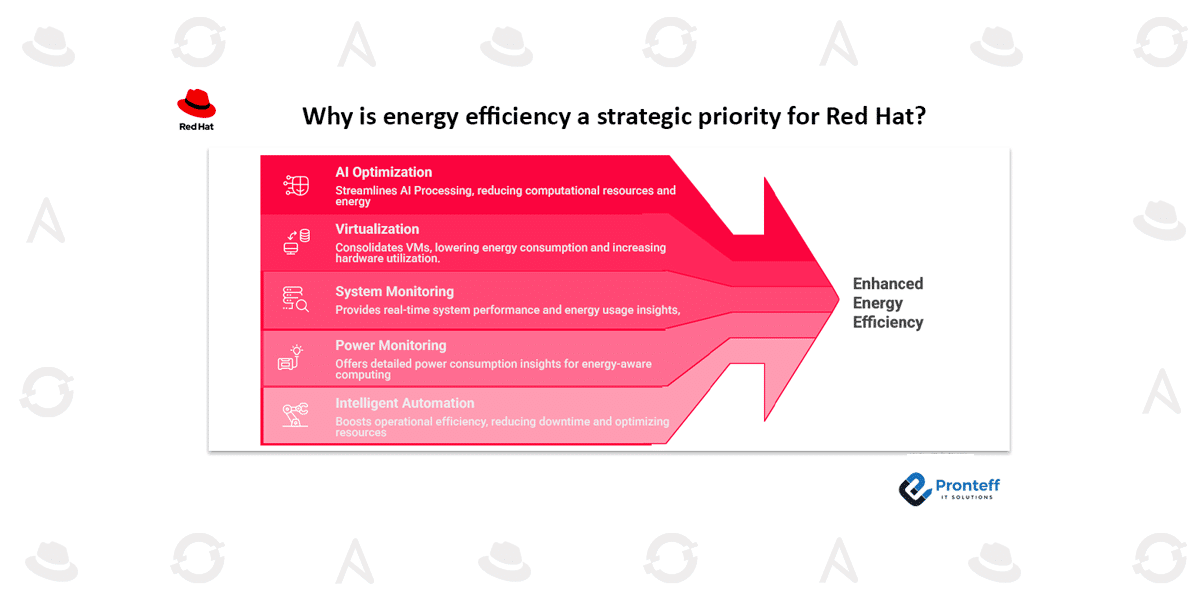Why is energy efficiency a strategic priority for Red Hat?
In this blog, we will learn why energy efficiency is a strategic priority for Red Hat.
Red Hat is making energy efficiency a key strategic focus to meet the growing demand from customers seeking sustainable IT solutions. Our initiatives aim to curb the rising energy needs of AI, cloud computing, and IT infrastructure—empowering organizations to innovate responsibly.
Red Hat Solutions for Sustainable IT Operations
Red Hat leverages open source technologies to enhance energy efficiency across hybrid and cloud environments. Our approach includes:
AI Optimization:
Red Hat AI enables smarter, faster, and more energy-efficient model deployment across the hybrid cloud. With Red Hat AI Inference Server, powered by vLLM, customers can maximize GPU utilization and achieve quicker inference results. This reduces computational overhead, power consumption, and costs associated with AI workloads.
Virtualization:
Red Hat OpenShift Virtualization consolidates multiple virtual machines onto fewer physical hosts, cutting down on energy use while improving hardware efficiency and utilization.
System Monitoring:
Red Hat Enterprise Linux (RHEL) integrates Performance Co-Pilot (PCP) for real-time monitoring of performance and energy metrics. This helps identify and correct inefficiencies quickly to optimize power usage.
Power Monitoring:
The Power Monitoring feature in Red Hat OpenShift provides detailed insights into power draw and workload behavior, helping organizations adopt energy-aware computing practices within their cloud-native ecosystems.
Intelligent Automation:
With Red Hat Ansible Automation Platform, organizations can automate repetitive processes, minimize downtime, and optimize resource allocation. These efficiencies lower energy consumption and contribute to a reduced carbon footprint.
Supporting Smaller Language Models (SLMs) for Greater Efficiency
Red Hat’s InstructLab open source initiative enhances large language models (LLMs) for generative AI while emphasizing the use of smaller, fine-tuned models. This approach minimizes the energy and computing resources typically required for LLM retraining.
Smaller language models consume significantly less power during training and inference. By tailoring models for specific domains or use cases, InstructLab enables high performance on energy-efficient CPUs rather than energy-intensive GPUs. This not only reduces environmental impact but also lowers operational costs—aligning with corporate sustainability and efficiency goals.
Business Advantages for Enterprises
Red Hat’s energy-efficient solutions deliver both sustainability and performance benefits, allowing businesses to operate more responsibly and cost-effectively.
Lower operational expenses: Optimized resource utilization and reduced energy demand help cut the total cost of ownership (TCO).
Sustainability alignment: Red Hat’s solutions support progress toward organizational carbon reduction and net-zero objectives.
Enhanced performance: Efficient resource allocation results in faster, more responsive applications and infrastructure.
Competitive differentiation: Adopting sustainable IT practices strengthens brand reputation and appeals to environmentally conscious stakeholders.
Collaborative Initiatives Driving Energy Innovation
Red Hat partners with industry leaders to drive real-world energy efficiency improvements:
SoftBank Collaboration: Red Hat and SoftBank are working on AI-RAN (Artificial Intelligence Radio Access Network) to reduce power usage in data centers supporting AI and vRAN workloads. This partnership integrates Kepler, a Red Hat-founded open source project, into SoftBank’s AI and Telecom Radio Access System (AITRAS). Kepler enables dynamic workload optimization based on real-time energy consumption, renewable energy availability, and carbon intensity.
Orange Partnership: Red Hat and Orange are collaborating to modernize telco cloud infrastructure using Red Hat OpenShift and Ansible Automation Platform. The initiative enhances efficiency by consolidating hardware, reusing existing resources, and utilizing power monitoring tools—helping Orange reduce its overall carbon footprint.
Conclusion
As organizations accelerate digital transformation, the importance of sustainable and energy-efficient IT continues to grow. Red Hat is at the forefront of this shift—combining open source innovation, AI-driven optimization, and a steadfast commitment to sustainability.
In today’s evolving digital landscape, energy efficiency isn’t just an environmental goal—it’s a strategic advantage. Red Hat is proud to lead this transformation, helping enterprises build a smarter, greener, and more resilient future.








